In this piece, authors Marcus Evans and Rosie Nance (Norton Rose Fulbright) examine the EU AI Act’s prohibitions, which took effect on 2 February 2025, carrying penalties of up to 7% of global annual turnover for non-compliance. Article 5 and its corresponding recitals (notably recitals 28-44) introduce a complex regulatory framework. The European Commission’s guidelines, published on 4 February 2025, provide much-needed clarity for those navigating these prohibitions.
This blog post explores key questions—both addressed and left open—regarding the scope and application of these prohibitions. It delves into restrictions on harmful subliminal manipulation and deception, exploitation of vulnerable individuals, social scoring, individual risk assessment and crime prediction, emotion recognition in workplace and educational settings, and biometric categorization used to infer ‘sensitive’ characteristics. The piece concludes with our perspective on the guidelines as a whole.
Do the Prohibitions Apply to ‘Providers’ and ‘Deployers’?
The prohibitions cover “the placing on the market, the putting into service, or the use” of AI systems for specific purposes. Notably, Article 5 does not explicitly reference the defined terms ‘provider’ or ‘deployer,’ leaving some uncertainty about whether its application is strictly limited to these roles or extends beyond them.
While the guidelines do not directly resolve this ambiguity, they center their discussion around ‘providers’ and ‘deployers,’ frequently using these terms in examples. This suggests that Article 5 primarily applies to these entities.
However, our interpretation is that the scope of Article 5 extends beyond just ‘providers.’ The prohibition applies to any entity that places a prohibited AI system on the market or puts it into service. The definition of ‘provider’ is restricted to those doing so under their own name or trademark, but Article 5’s language does not impose such a limitation. Thus, regardless of branding, any entity involved in making a prohibited AI system available or operational falls within its purview…
